This is an Argus C3 Matchmatic rangefinder camera made by the Argus Company in Ann Arbor, MI. The Argus C3 was in production from 1938 – 1966 making it the longest lived and best selling American made camera of all time. This C3 is the first old camera that I personally cleaned, lubed, and adjusted (CLA for those of you who collect old cameras). According to the Argus Camera Information Reference Site, I was able to conclude that my camera was made in 1958, which was the first year of the Matchmatic variant of the C3.
Film Type: 135 (35mm)
Lens: 50mm f/3.5 coated Cintar 3 elements
Focus: 3′ to Infinity
Type: Coupled Split Window Rangefinder
Shutter: Leaf
Speeds: B, 1/10 – 1/300 seconds
Exposure Meter: Selenium Accessory Shoe
Battery: None
Manual: http://www.butkus.org/chinon/argus/argus_match-matic/argus_match-matic_c3.htm
History
The Argus C3 was an American made 35mm film camera made between the years of 1938 – 1966 by Argus, which was based out of Ann Arbor, Michigan. Due to its incredible 28 year production run, it remains one of the most popular and best selling cameras of all time.
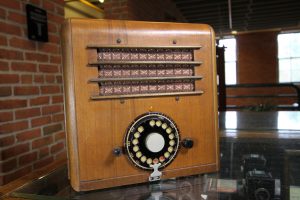
Argus was founded in 1931 as the International Radio Corporation (IRC for short). Back then, IRC made a variety of different radios, some of which had pioneering designs. IRC’s products included the Kadette which was the first mass produced AC/DC radio. Although it looked to be made of wood, it was actually made from Bakelite plastic which made it inexpensive and portable. It sold extremely well and branched into other Kadette products like the Kadette Jr, which was the world’s first pocket radio, and the Kadette Clockette which was one of the first clock radios.
Although successful at selling radios, IRC wanted to expand their business and take advantage of their skill at making products out of Bakelite plastic. In 1936, IRC would release their first camera, the Argus Model A. The Model A was a very basic viewfinder camera with a collapsible lens, and a basic f/4.5 lens and 3 shutter speeds.
The Model A was very successful, selling for as little as $10 which allowed many people to buy one who couldn’t otherwise afford a camera. IRC’s camera business was so successful that the camera would change its name to Argus in 1939 and sell off the radio business.
Although the Model A was successful, it was a pretty basic camera, and Argus saw the need for a more advanced design, so in 1938, they released the Model C (there was also a Model B, but it was merely a variant of the Model A with a German shutter) which sold for $25, and was made out of a combination of Bakelite plastic and aluminum front and rear plates. The Model C had a unique split image rangefinder, and supported interchangeable lenses, two features that were unheard of at the $25 price point.
The C3 came out only 4 years after Kodak had introduced its new 35mm 135 format film which was designed for the Kodak Retina. This new film format was also very popular by German manufacturers such as Leitz, Zeiss-Ikon, Certo, Welta, and other Dresden based manufacturers. Although Kodak was an American company, its Retina cameras were made in Germany by an branch of Kodak which was originally known as Nagel Kamerawerk. All of these cameras were well designed, precision made photographic instruments, but they were all very expensive.
When Argus released the Model A, it was the cheapest made camera that could also use this new 135 format. Although costing double of a Model A, the Model C was still a huge bargain compared to its German competitors. It was this ultra-low price point that allowed the Model C to be the long lived success that it became. Variants of that original Model C from 1938 would be in production until 1966.
Although there was an Argus C and C2 prior to the C3, they were only made for a couple of years, and other than a couple of minor changes, they looked very similar to the C3. For the purposes of this article, we’ll say that the C3 was in continuous production starting in 1938.
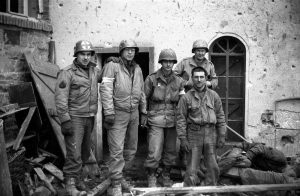
The Argus C3 was an immediate hit and became popular with amateur photographers due to its relatively small size, durability, above average optics, easy to use rangefinder, and use of 135 film. When the United States entered World War II, the Argus became a very popular tool on the battlefields. Many photographs in today’s history books of WWII battles were taken with Argus C3s. As a matter of fact, the C3 was so well built, that the US Army issued field service and repair guides for Argus C3 cameras in the event that any needed to be serviced in the field. After the war was over, the C3 still sold very well despite more capable models of cameras becoming available by other American, German, and Japanese companies.
By the late 1950s, the Argus was starting to show it’s age and sales began to slow. To help re-ignite interest in the camera, Argus came out with a couple of variants of the C3. My model is called the Matchmatic C3, and its most noticeable new feature is the included accessory selenium light meter that sits on top. In an effort to appeal to more amateur photographers, things like aperture and shutter speed settings were replaced by an exposure numbering system that Argus thought would be easier to understand by people who weren’t familiar with the technical terms of photography. For example, if you were shooting outdoors, you would set your film speed, point the light meter at your subject, and it would tell you which settings to use on the camera for proper exposure. Although this is still a completely manual process, it was designed to help people get a more accurate exposure without knowing a lot about lighting.
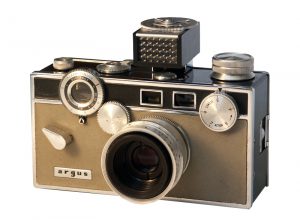
Another distinguishing feature of the Matchmatic C3 was that unlike every other Argus C3 made before it which only came in black, the Matchmatic came with a two tone black and tan leatherette covering. The strip of leatherette on the top part of the front of the camera remained black, but the rest of it was tan. There was another variant of the C3 called the Golden Shield, which was very similar to the Matchmatic feature wise, but came with an all metallic covering. These changes allowed the C3 to remain in production for another 8 years before it was finally discontinued in 1966.
Today, the Argus C3 is still sought after by collectors of old cameras due to its history, distinct looks, and as a testament to its rugged design and well built mechanics, most C3s still work fine after all these years. The C3 sold so well, that it helped popularize the 135 film standard. Although no one could really know for sure, its possible that had the C3 never been made, another standard could have come along and become the dominant film standard.
The camera’s distinct brick-like design earned it the nickname “The Brick”, and its unique looks make it a popular choice for filmmakers who make movies set in the 30s and 40s. Argus C3s have appeared in movies such as The Philadelphia Story, Sky Captain and the World of Tomorrow, and even Harry Potter and the Chamber of Secrets.
It is estimated that around 2 million of these cameras were sold over its 28 year life cycle, and many famous people used them. Jimmy Carter even owned one and his exact camera is on display at the Jimmy Carter museum in Atlanta.
I like this camera for its history and its cool looks. There simply was not another camera made that looks anything like the C3. For many years, designers have been conscientious about ergonomics and making things feel comfortable in your hand. The C3 is the exact opposite of that. It is a clear example of “function over form”. Although its not incredibly uncomfortable to hold, its 90 degree corners, and relatively heavy weight can make it difficult to use for people with small hands.
As I mentioned above, I tore my camera completely apart and cleaned and serviced the camera to an almost “like new” condition. Another appealing factor of the C3 is how easy it is to service. I have read on sites that its the Ford Model T of cameras. You literally just need a set of precision screwdrivers to take this thing apart. The leather covering on the front hides 6 flat head screws, that when removed, allow you to gain access to all of the innards of the camera.
The one you see here was very dirty when I got it, but after the reading I did online, I felt pretty confident I could do a pretty good job of restoring it. Although I probably could have saved the original leatherette, it was dirty and torn, and when I removed it from the camera, it started to fall apart, so I figured I would just order a leather kit from www.cameraleather.com and recover it myself. Since no one out there makes an exact match to the Matchmatic’s black and tan leather, I decided to be unique and order a black and blue kit to give my camera an even more distinct look!
After putting my camera back together and loading in my first roll of film, I was able to get a couple of good shots from the camera. The 50mm f/3.5 lens is reasonably sharp and bright. This lens renders out of focus light in a “swirly bokeh” pattern that is very distinct. Theres nothing incredibly amazing about this camera other than the fact that it still works and is capable of some nice shots.
My Results
Not really knowing what I was doing with my first roll, and my lack of experience with a 100% manual camera, not every shot I got out of my first roll came out great, but I still got some decent shots. I used pretty basic Fuji 200 film and tried my best at the Sunny 16 rules when shooting. Although the needle on the selenium light meter does move, selenium light meters are not known to be accurate after 50+ years, so I didn’t rely on it.
The colors seem to be a bit muted, but the contrast and sharpness are good. The lens has noticeable vignetting in the corners. Vignetting is when the corners of a picture are darker than the middle. Many old cameras have vignetting, and its actually a popular thing to do with many smartphone apps like Instagram which intentionally give new pictures a “vintage” look. The vignetting you see here is straight out of the camera. If you look at the picture of the gargoyle above, you can see heavy vignetting and the “swirly bokeh” I mentioned earlier.
I actually really enjoy using this camera. The rangefinder is incredibly easy to use. Unlike later rangefinders where two images are superimposed on top of one another, with the C3, there are 2 separate viewfinders in the back. The right one is a split rangefinder where the top half of the image is clear, and the bottom half is yellow. You turn the focus ring until the two images are lined up and thats how you get focus. Once the image is in focus, you move your eye to the left viewfinder which is set to a 50mm frame.

One feature of the C3 that I haven’t yet mentioned which also contributed to its popularity, was that it had interchangeable lenses. This was pretty unheard of at the time on an entry level camera. At the time, only the high end pro cameras had interchangeable lenses. The vast majority of C3s were sold with the 50mm lens, but there were wide angle and telephoto lenses available as well.
Once you have both your focus set, and your image composed, you need to cock the shutter by pressing down on the chrome lever on the front until it clicks and then you fire the shutter with the shutter release button on the top of the camera. The Argus C3 supports shutter speeds from 1/10 to 1/300 of a second, and it also has a B mode for long exposures.
After taking your shot, you advance the camera to the next frame by holding down the film catch lever and turning the winding knob a quarter of a turn, and then releasing the film catch, and continuing to turn the knob until it stops.
As a whole, using the C3 is a fun experience and I can’t wait to shoot more film with mine. Theres something to be said about using any old camera and appreciating them for their nuances. You have to get back in touch with the fundamentals of photography when you use an all manual camera, but when you do it on a camera with such a unique design and with so much history, its an experience I recommend for anyone looking to get into this hobby.
Update 4/5/2015
It took me a while, but I shot a second roll with my Argus around Christmas of 2014 at my in-laws in northern Michigan. I still struggle with getting consistently good shots out of this camera, but this time about half of the roll was good. This camera seems to alter the colors in strange ways. Being a 1958 camera with a lens that’s supposedly coated for color, the colors always seem to be muted. Low light shots produce some really crazy looking colors. I updated the photo gallery above with 7 new shots and the one of the Christmas tree really shows the strange colors.
I’m not saying its a bad thing, rather its exciting to see what the shots will look like when I get the film back. If only I could master the focus a little better.
Earlier this year, I decided to spend more time with this camera to discover why I had such a hard time getting shots in focus, and after comparing this camera with other C3s that I had access to, I came to the conclusion that at some time in the camera’s past, someone had disassembled the lens and put it back in the wrong order. The focus helical was inserted incorrectly.
I didn’t document my repair since most of it was trial and error, but if you look at the image to the right, you can see this camera with a different C3 lens attached. In this image, the lens is screwed down all the way to what should be infinity focus. The issue is in how the toothed gear on the bottom meets up with the body of the camera. In this image, the lens is correctly installed. When I would install the Matchmatic’s correct lens, these teeth were in a different orientation. I had to manually disassemble the lens and put it back together so that it’s teeth matched the orientation of this other lens.
I fully realize that this explanation probably doesn’t make a lot of sense, and I regret not documenting this better, but all I can say is if you have a Matchmatic that never seems to get focus correct, its probably the lens. See if you can get another, known good, C3 lens and compare yours with it. Everything should match up the same.
| My Final Word | The Argus C3 is the perfect entry into shooting and collecting vintage cameras. It offers a unique design, vintage feel, is very easy to use, and the Cintar lens is capable of very nice shots. If something is wrong with your C3, it is also one of the easiest cameras to repair. Even someone with no camera repair experience can repair a C3. The best part about the C3 is how cheap they are. You can easily find them for $10 – $20 on eBay so there is little to no risk in trying one. | ||||||
| Images | Handling | Features | Viewfinder | Feel & Beauty | History | Age | |
| 1 | 0 | 1 | 1 | 1 | 2 | 40% | |
| Bonus | +1 for its historical significance as the most popular American made 35mm cameras of all time, and its role as a field camera during WWII | ||||||
| Final Score | 9.4 | ||||||
Additional Resources
http://en.wikipedia.org/wiki/Argus_C3
http://mattsclassiccameras.com/argus_c3.html
http://camerapedia.wikia.com/wiki/Argus_C3
http://shotonfilm.wordpress.com/the-cameras-2/argus-c3-the-brick/
http://mconnealy.com/vintagecameras/argusc3/index.html
http://blog.dcview.com/article.php?a=AD5TMQxuAjI%253D (In Chinese – Use Google Translate)

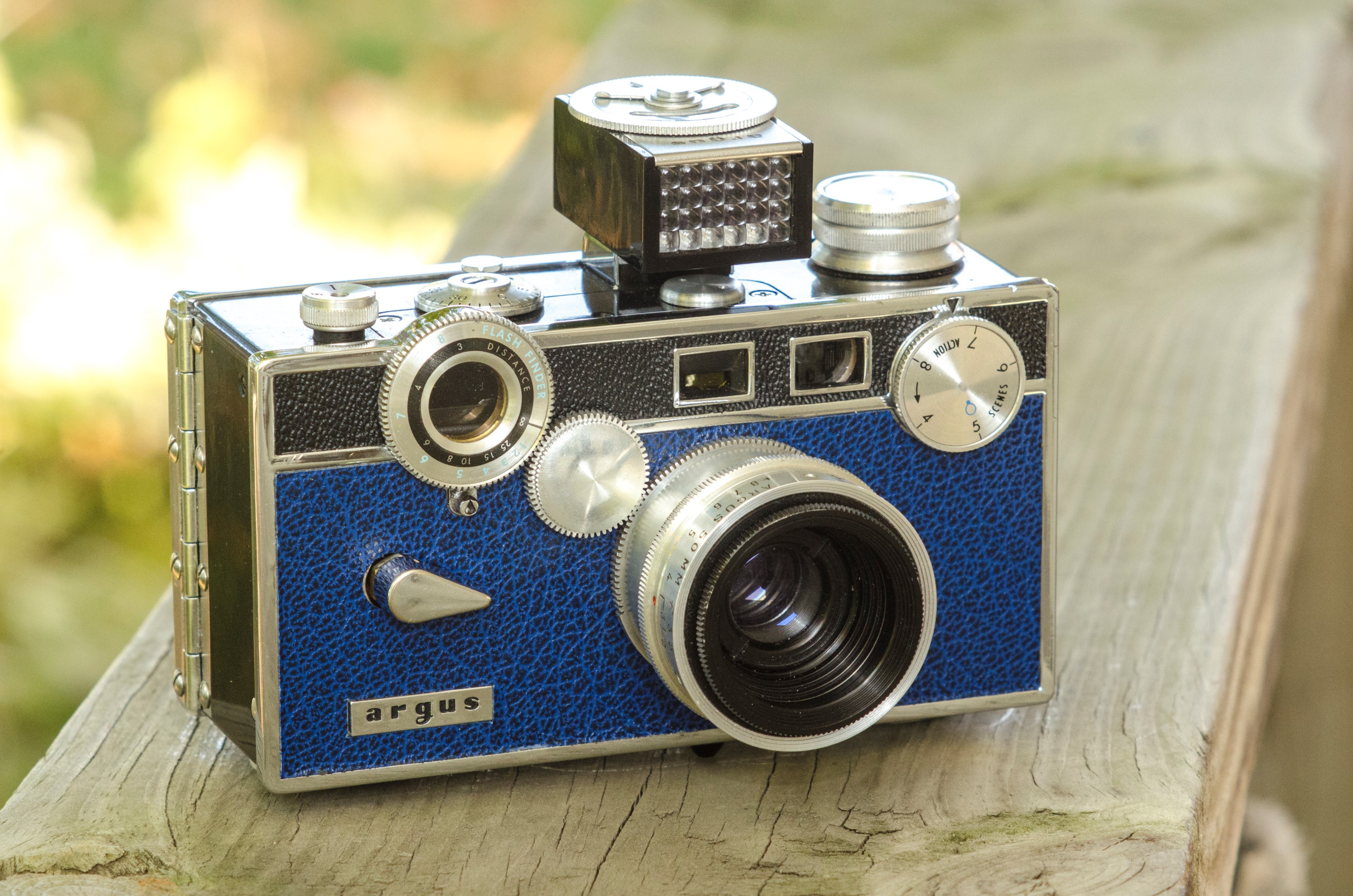
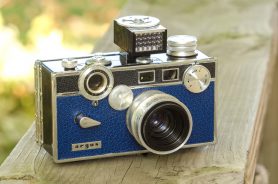
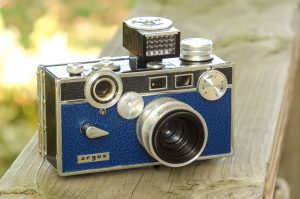
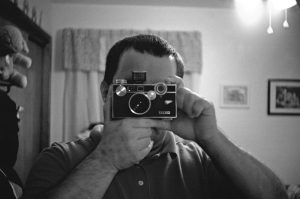









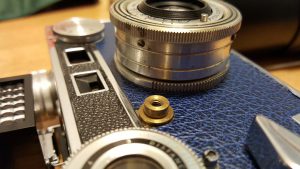
Great article! I just picked up a near-mint Matchmatic at a thrift store ($5.00) and it works beautifully. Of course, the true test will be running a roll of film through it. Mine dates to 1959, so I am amazed at its condition. All I had to do was clean the glass on it Oh, and the light meter is completely dead. Big surprise…
I have monkeyed with taking apart a C3 before, and there is a little trick to getting the lens on right. If it’s off a tooth or two your rangefinder won’t know it, and you could THINK you are getting things in focus when in fact you’re not. It’s the one problem with rangefinders that has been corrected with TTL focusing. But then, if your vision isn’t perfect, a SLR isn’t as good as a properly adjusted rangefinder.
One trick I have learned is to put a piece of painter’s tape on the face of the camera and make a corresponding mark on the tape and a tooth on the lens barrel before taking off the lens. Count the number of turns it takes before the lens comes off. Then, when you put it back together you can pretty well realign the lens, at least to where it was when you started. If someone misaligned it before you got it you’ll still have a problem. Perhaps the field repair guide has some pointers on making sure the lens is on properly. Best of luck!
Throughout all of 2015, I have kept meaning to come back to my C3. The only two rolls I shot in it were in the fall and winter. I never really gave it a chance during the bright and color spring and summer months, yet here we are again in October and I still haven’t pulled it out.
I have too many other cameras I guess! 🙂 On the bright side, I just finished my first roll through a recently CLA’d Argus 75, and I have an Argus A2F which appears to be in excellent condition that I am eagerly awaiting a chance to shoot a roll in! Who knows. maybe the older A2F will turn out better pictures than my C3! 🙂
What a great article. Thank you! I just purchased an Argus C3 Match-matic from e-bay and have finished my first roll. Now it’s just the wait of getting it developed. One thing that I find fascinating is that the light meter works well when compared to the light meter that I have on my smartphone. I think I even understand the proprietary numbering system for the lens and shutter speed to work with the EV scale.
Love your article. I just was given an Argus C3 for a trade and find it quite a fascinating camera once you find out how everything works. I grew up in Ann Arbor and heard of the Argus company but never tried their wares until now. Time to give this old camera the CLA it deserves.
John Flinn
milke,, to properly lube a C3 do you drill a hole in it and tap it for 1/8 27 NPT and screw in a grease zerk???
Garry in Flint (self-proclaimed Argoholic )
Thanks for the great info. and links! I used my Dad’s C3 as a teen in the early 70’s but sold it later on in life. I just picked up a C3 Matchmatic for $20 at an antique store, I’ve cleaned it and have my first roll of Tri-X loaded!
Very cool! The Argus C3 series has a bit of a learning curve for someone not familiar with it, but once you get over that, you’ll be quite surprised at the images it can make. It really is a solid camera!